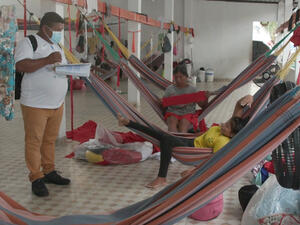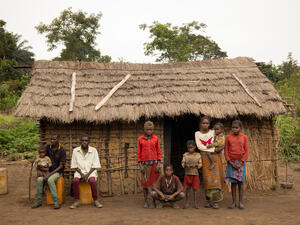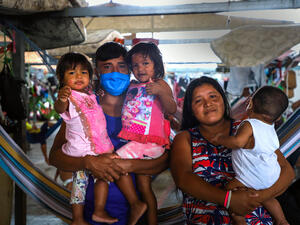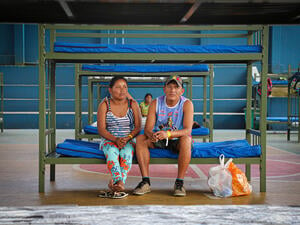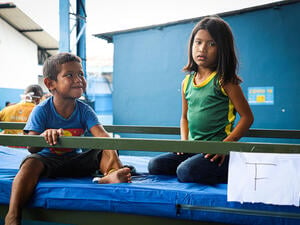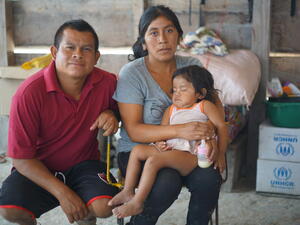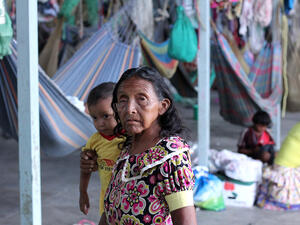Indigenous survivors mark anniversary of Colombian massacre amid hope and fears for the future
Indigenous survivors mark anniversary of Colombian massacre amid hope and fears for the future
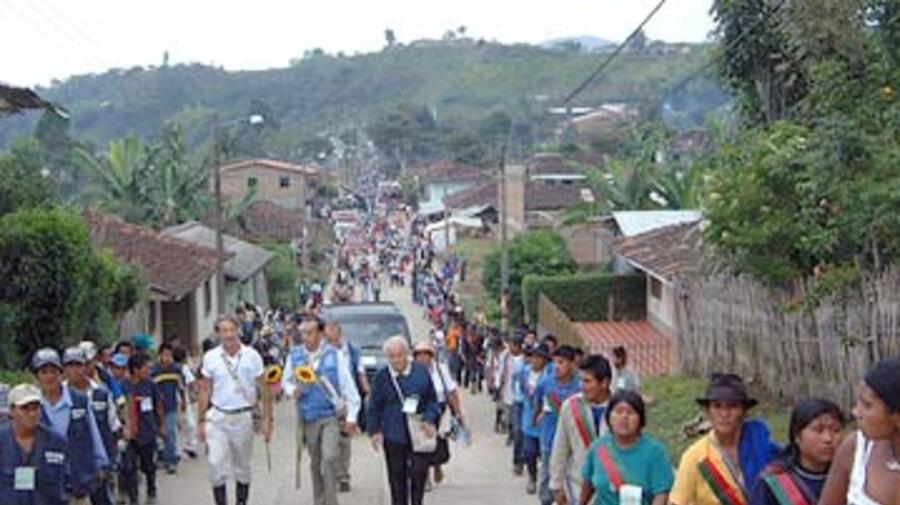
At Caldono village, UN staff received a special recognition from the indigenous peoples of the Cauca region of Colombia.
CALDONO, Colombia, April 14 (UNHCR) - Armed only with their moral strength and a wooden baton as a symbol of their authority, the men and women of the Guardia Indígena (indigenous guard) of the Cauca have confronted ruthless guerrilla and paramilitary fighters armed to the teeth and persuaded them to turn back and leave their villages.
On at least one occasion, they succeeded in rescuing two kidnap victims by walking up to the place where members of an irregular armed group were keeping them and convincing them that they should release the hostages unharmed.
This time, they were gently nudging the crowd to open a way for us to walk up to a podium in a disused factory in the village of Caldono. All around us, there were over 12,000 delegates, representing the estimated 250,000 indigenous inhabitants of the Cauca. This south-western province has the largest indigenous population in Colombia. We were there at the invitation of the Indigenous Regional Council of Cauca, the highest traditional authority in the province, recognised as having a special jurisdiction over their own territory by the Constitution and the government of Colombia.
We had been summoned in order to receive a very special recognition: we were going to be honoured as defenders of the rights of indigenous people. Our delegation included the UN Humanitarian Coordinator in Colombia, the UNHCR Representative and the Director of the Office of the UN High Commissioner for Human Rights.
"We value your efforts, your solidarity and your contribution. As defenders of life, you are defending us," a member of the Council said in his welcome speech.
"We the Yanaconas, Guambianos, Ingas, Emberas, Nasas, Coconucos and the other peoples represented here, don't want to be involved in a war that doesn't concern us," another leader said. "We, the excluded and humiliated original inhabitants of Colombia, don't want to be massacred, murdered and displaced. We are continuously threatened by war and the destruction of our lands. But we will continue to resist as long as the sun shines up in the sky."
It was then announced that we were going to receive a special mandate from the traditional authorities. A group of women leaders came up to the podium carrying mochilas, the cotton shoulder bags worn by every indigenous man and woman in this part of Colombia. One of them spoke: "Every person, every being and every thought is made up of a male and a female part. For us indigenous people, these mochilas represent the womb. We hereby give you the symbol of life so that you will defend it. May you always remember this mandate."
A representative of the Afro-Colombian communities also spoke: "On behalf of the more than 22,000 indigenous and Afro-Colombian inhabitants of the Naya River region, I greet you and present you with a petition. We request the support of the international community in obtaining titles to our lands and in learning the truth about the April 2001 massacre."
In the dark annals of violence in Colombia, the Naya massacre occupies a special place. Exactly four years ago, during Holy Week, a group of 400 paramilitaries entered this remote jungle area. A few days earlier, ELN (National Liberation Army) guerrillas had staged a mass kidnapping of worshippers in a nearby church, and the paramilitaries accused the villagers of aiding the guerrillas. In an orgy of violence that lasted from April 10-13, scores of people were murdered in the most gruesome ways (the exact number of victims is still unknown, but estimates range between 70 and 130).
"The remains of a woman were exhumed. Her abdomen was cut open with a chainsaw. A 17-year-old girl had her throat cut and both hands amputated," said the then Ombudsman, Eduardo Cifuentes, after visiting the site of the massacre. Over 3,000 mostly indigenous people were displaced as a result of the killings.
Some of the survivors of that massacre were present at the event in Caldono. They came up to the podium with a large sunflower each, holding them ceremoniously like yellow flags. "In memory of my father I give you this flower," a small boy no older than eight or nine told me. Some of the youngest children found it too painful to repeat these words and their young voices broke into sobs.
We were very moved and could hardly hold back our tears. These widows and orphans from the Naya were still displaced, four years after the massacre. Some of them had been living in a bullfight arena in Santander del Quilichao, where some 380 men, women and children spent three years in appalling conditions until, last year, the authorities gave them an abandoned farm near the provincial capital, Popayán, where they have started a new life.
We visited the farm the next day. The neighbours still refer to it by its original name of "La Laguna", but the 70 families from the Naya that have settled there have given it a new name: "Kitek Kiwe", which in the Nasa language means "the flowering land". Here the community, with some help from non-governmental and international organisations, have begun planting maize, beans, cassava, squash and other vegetables. They also have 15 head of cattle, a horse and a mare, and are building a school where the children will receive tuition in both Spanish and Nasa.
The young people keep busy with cultural activities including music, reading and broadcasting through a public address system. Much has been accomplished by the community, but many difficulties still remain. Living conditions are poor and the community's health has suffered as a result of a lack of clean water and proper sanitation.
The main concern of the community, however, is security. "We know that irregular armed groups operate a very short distance from here," one of the residents said. "We are very worried that they may want to take reprisals against us, especially since we have given testimony in court against some of them. We have the Guardia Indígena, but they are not armed."
After much suffering, this group of survivors of the Naya massacre are looking forward to a peaceful and self-sufficient life. "We are here to stay," says a community leader. "We will not leave this place, not even when we're dead. That's why we are also building our cemetery here."
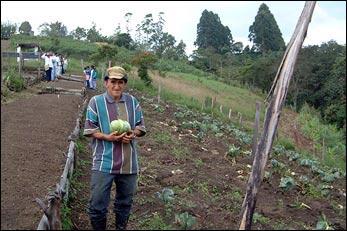
"Kitek Kiwe", or "the flowering land" in the Nasa language, is now home to some of the indigenous people displaced by the Naya massacre of April 2001.
"Despite the protection problems that they continue to face, we think that this community could offer an example of the successful integration of a displaced community in a rural setting," says Saskia Loochkartt, a consultant on indigenous issues with UNHCR. "The internal organisation of the community and the good inter-ethnic relations with their non-indigenous neighbours are particularly significant."
UNHCR, true to its commitment to the protection of displaced communities and communities at risk, will continue to follow up closely the situation of the "Kitek Kiwe" community to ensure that it continues to flourish in the middle of the conflict.
By William Spindler
UNHCR Colombia

